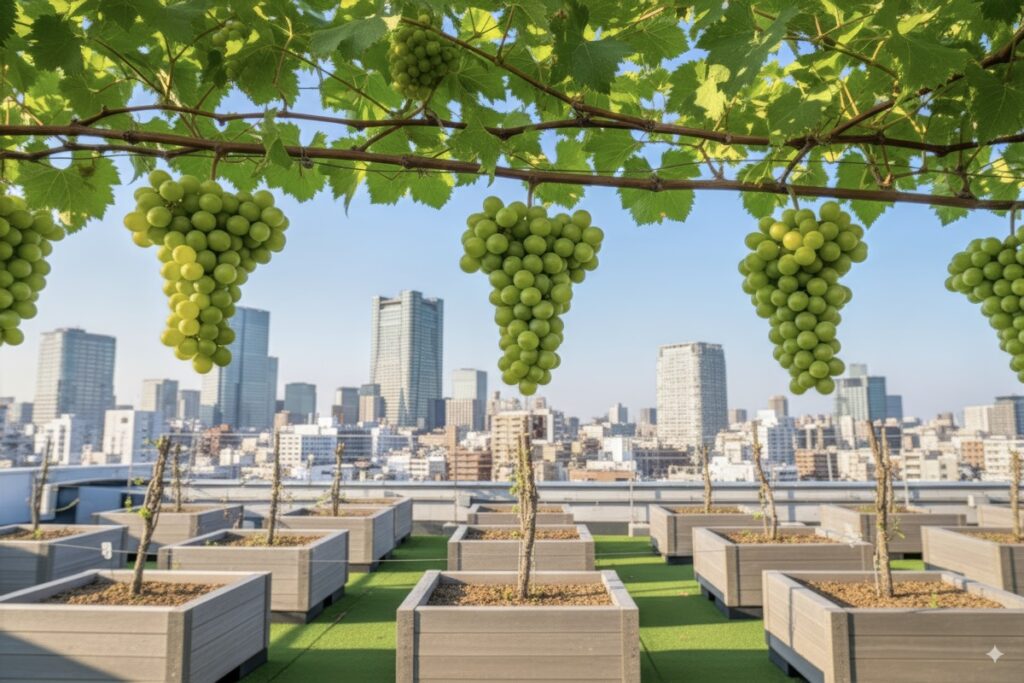A Vineyard on a Rooftop
Vineyards usually bring to mind sloping hillsides and sunlit terraces. In Fujisawa, a coastal city near Tokyo, wine grapes are thriving on an office rooftop. A quiet, radical shift is underway: urban winemaking in Japan. At the center of it is a grape with a name that sounds like myth, Maeve.
An Accidental Discovery
Maeve was found in 2019. DNA testing showed it was not just rare but entirely new, with no match in global databases. Scientists at the Okinawa Institute of Science and Technology later confirmed it as the only variety of its kind.
Novelty is only the start. Maeve is grown without pesticides and is remarkably tough. It survives the minus-30-degree winters of Hokkaido and the tropical heat of Okinawa, producing fruit in both places. In a warming world, that resilience feels less like luck and more like a sign of what is to come.
From Satellites to Vines
The grape’s unlikely guardian is Toshitada Tanaka, a former satellite engineer and IT entrepreneur. Near retirement, he inherited his grandfather’s vineyard. Curious about one vine, he ordered DNA testing and learned it had no record anywhere. “I whispered to myself, this is a miracle,” Tanaka recalls. That moment turned him from engineer to vintner.
Maeve’s Superpowers
Maeve has been farmed without pesticides for more than twenty years. Genomic work suggests a cross between Riparia Gloire, a disease-resistant North American rootstock, and Vitis vinifera, the European lineage behind Cabernet and Chardonnay. In Okinawa, vines can grow up to six meters in a year, raising the possibility of two harvests per season.
Farming for the Future
Because it does not require chemicals, Maeve invites community involvement. Students already volunteer in the vineyards, and social welfare groups are exploring projects where children and people with disabilities can help with winemaking. The aim is wine not only as a luxury good but as a tool for inclusion.
From Ryukyu (Okinawa) to Ginza
Expansion is underway. Nakijin in Okinawa is planning a “Ryukyu Wine,” while rooftops in Tokyo’s Marunouchi and Ginza districts are being planted with Maeve. Odawara has set 700 vines near the historic One-Night Castle for a local wine, and fishermen in Chiba are preparing seafood-friendly blends. Each project ties wine to place and to community identity.
Why Local Wine Matches Local Food
Maeve illustrates an old truth: wines tend to pair with foods from the same place. Coastal climates yield crisp whites that lift seafood. Hot inland regions produce tannic reds that meet beef or lamb head-on. The science is simple, acidity cuts fat and tannins bind proteins. The tradition is deeper, local cuisines and local wines evolved together until they fit.
Stainless Steel, Made in Shonan
Tanaka’s company, Shonan Co., is also building Japan’s first domestically produced stainless-steel wine tanks with local factories. Until now, wineries relied on imports, a risky bet when fermentation will not wait. Stainless steel dominates modern cellars for precise temperature control, sanitation, and flexibility. For Tanaka, making tanks locally is both practical and philosophical. “If the grapes are Japanese, the tanks should be too.”
Toward a Third Japanese Wine
Today, Japan’s signature grapes are Koshu and Muscat Bailey A. Maeve may soon stand beside them as a third pillar. Hardy, chemical-free, and versatile, it offers hope to a wine world wrestling with climate change.Tanaka, once an engineer of satellites, now tends vines with the same care. “It feels like nature handed us a ticket to the future,” he says.
Perhaps Maeve will not only reshape Japanese wine. It may help safeguard the future of wine everywhere.
These days in France, making wine feels like rolling dice. Some years the frost arrives late, just as the buds are tender. Other years, storms drench the vines right before harvest. Along the Mediterranean it is heat and drought. In the north and on the Atlantic coast it is unending rain and rot. Every season brings a new disaster. Too hot, too wet, too dry, too cold. Sometimes hail. Sometimes mold. A trouble-free year? No one remembers the last one.
Growers are waiting for a savior grape, something that won’t flinch at extremes. There is a candidate now, Maeve. If it can handle the snows of Hokkaido and the tropical air of Okinawa, perhaps it could face Bordeaux, Burgundy, Champagne. Perhaps, crossed with French vines, it could keep the flavor and perfume the French live for and still deliver a steady crop. Imagine that.
Its backstory reads almost like a novel. It was not discovered at a grand estate in Burgundy or in a lab in Montpellier. It surfaced in an old man’s vineyard in Fujisawa, Japan. The person who first noticed it was not even a farmer. He used to build satellites and ran an IT company. He took over the vineyard from its owner near retirement and sent a vine for DNA testing to identify the variety. The lab reported no match. A true original. Literally, a miracle.
There is a neat symmetry here. In France, growers already use satellite data to track their vines, a practice they call precision viticulture. So perhaps it is not strange that a former satellite engineer found the grape the world had been waiting for. Still, it feels like the sort of coincidence that makes you pause.
Scientists around the world are racing to create grapes tough enough for the new climate. Yet this one, Maeve, was already here, growing quietly and unnoticed in a small vineyard. You can picture the researchers shaking their heads and laughing at the absurdity of it. That is the thing about plants. Sometimes, against all odds, they hand you a miracle. And that keeps the whole game interesting.


